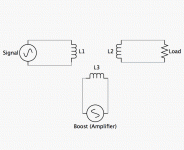Member
Joined 2009
Paid Member
The Susan Parker amplifier got me thinking about this. If I can bend the rules and pretend that a transformer is a piece of wire then a perfect amp could be a transformer with gain. There are some very old references to hysteresis-switching transformers from before active devices were invented but that's not my question.
There are 3 coupled inductors (transformer) where the turns ratio gives a voltage gain from the input to the output. It could be 20.
With no load the back emf from the secondary is out of phase with the primary. They cancel and there is only just enough current flowing in the primary to magnetize the core. This is the highest impedance state for the input.
Connect a load. The back emf phase shifts so that it no longer cancels out the voltage in the primary, which now starts to draw current. As soon as it does the high output impedance of the source results in a voltage drop and soon enough there's nothing doing at the output.
Enter the third coupled inductor. It's job is to compensate (outside of the signal path). There are different ways to look at this but essentially it's job is to ensure that it drives a current that produces a back emf at the primary which matches the input signal and maintains a high input impedance. The same back emf drives current through the secondary which power the load (a speaker). It's a voltage buffer.
Another way to look at this is that the boost input maintains a unity power factor in the transformer.
I'm sure this is either not new or stupid, but I thought I'd throw it out there....
There are 3 coupled inductors (transformer) where the turns ratio gives a voltage gain from the input to the output. It could be 20.
With no load the back emf from the secondary is out of phase with the primary. They cancel and there is only just enough current flowing in the primary to magnetize the core. This is the highest impedance state for the input.
Connect a load. The back emf phase shifts so that it no longer cancels out the voltage in the primary, which now starts to draw current. As soon as it does the high output impedance of the source results in a voltage drop and soon enough there's nothing doing at the output.
Enter the third coupled inductor. It's job is to compensate (outside of the signal path). There are different ways to look at this but essentially it's job is to ensure that it drives a current that produces a back emf at the primary which matches the input signal and maintains a high input impedance. The same back emf drives current through the secondary which power the load (a speaker). It's a voltage buffer.
Another way to look at this is that the boost input maintains a unity power factor in the transformer.
I'm sure this is either not new or stupid, but I thought I'd throw it out there....
Attachments
Gareth,
Two big issues - the distortion, of course, and the impedance conversion.
If we go for a gain of 20, then if source impedance is just 600 ohms, our output impedance becomes 240K, and clearly we need a high gain current amplifier to drive an 8R speaker.
Susan does this with source followers, but really, all you replace in the transformer amplifier is the input stage and the voltage amplifier, and you still have to accommodate negative feedback, indicating even higher open loop gain.
Parasitics with trafos are not trivial - this would be expensive, and may not deliver low distortion. Your idea is pretty nifty, but you are still up against it.....
Hugh
Two big issues - the distortion, of course, and the impedance conversion.
If we go for a gain of 20, then if source impedance is just 600 ohms, our output impedance becomes 240K, and clearly we need a high gain current amplifier to drive an 8R speaker.
Susan does this with source followers, but really, all you replace in the transformer amplifier is the input stage and the voltage amplifier, and you still have to accommodate negative feedback, indicating even higher open loop gain.
Parasitics with trafos are not trivial - this would be expensive, and may not deliver low distortion. Your idea is pretty nifty, but you are still up against it.....
Hugh
Member
Joined 2009
Paid Member
Lumba Ogir said:Gareth,
transformers are from a distortion perspective very far from a piece of wire.
I was thinking that if it would work with a transformer it would also work without one - if you think of an end goal in which there really is only a piece of wire in which the signal is boosted as it travels along it. The microwave guys do this using a traveling waver amplifier for example where the amplifier is electromagnetically coupled with the signal. A little bit of gain is given to the signal over a certain distance and after a long enough distance you get a lot of gain. The gain can be added at a low level where distortion and other issues are easier to deal with.
Anyhow, it was just a crazy thought.
- Status
- Not open for further replies.
